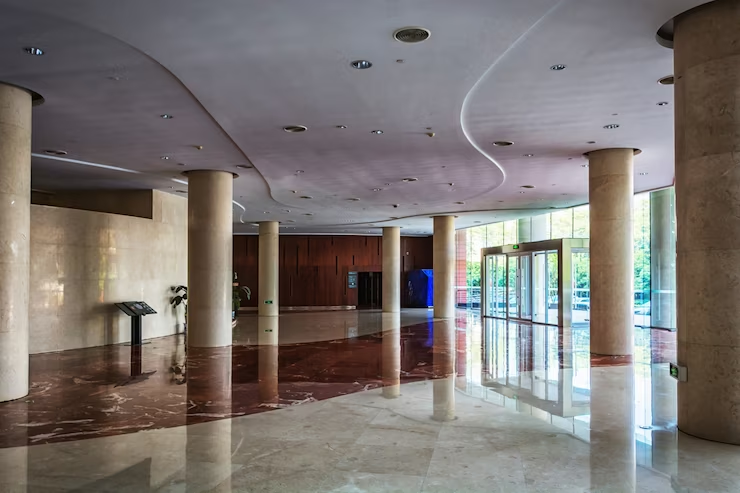Building Hotels for Safety: Key Considerations and Best Practices


Brian Jeffries
Brian Jeffries, a seasoned BPA Advisor. Brian is dedicated to sharing his wealth of knowledge on construction projects and materials. With a focus on architecture and building envelopes, Brian contributes valuable insights that shape the discourse around innovative construction practices and materials.
When it comes to constructing hotels, safety should always be a top priority. Ensuring the well-being of guests and staff is not only a legal requirement but also crucial for building a positive reputation and fostering trust. From designing sturdy railings to installing smoke curtains, this article explores two essential safety aspects in hotel construction and best practices to enhance security for all.
Hotel Railings: Balancing Aesthetics and Safety
Railings in hotels serve a dual purpose – providing support and preventing accidents while also contributing to the overall aesthetic appeal of the property. When designing and installing hotel railings, the following key considerations and best practices should be taken into account:
Complying with Building Codes and Regulations
Before beginning any construction, it is essential to familiarize yourself with local building codes and regulations. Different jurisdictions may have specific requirements for railing height, spacing between balusters, and load-bearing capacity. Adhering to these codes ensures that your railings meet safety standards and reduces the risk of accidents.
Choosing Durable and Low-Maintenance Materials
Hotel handrails are subjected to heavy use and varying weather conditions, making material selection crucial. Opt for durable materials such as stainless steel, wrought iron, or aluminum that can withstand the test of time and require minimal maintenance. Additionally, consider finishes that are resistant to corrosion and wear, extending the lifespan of the railings.
Prioritizing Fall Prevention and Child Safety
Guest safety, especially regarding fall prevention, is of utmost importance. Ensure that the spacing between balusters is narrow enough to prevent small children from slipping through. Incorporating child-safe features like self-closing gates or latch systems in designated areas, such as balconies and staircases, can further enhance safety.
Integrating Design and Safety
While focusing on safety, hotel railings should also blend seamlessly with the hotel's design and ambiance. Collaborate with architects and interior designers to create a harmonious look that complements the hotel's overall aesthetic while maintaining the highest safety standards.
Smoke Curtains: Enhancing Fire Safety Measures
In the unfortunate event of a fire, smoke curtains play a crucial role in containing smoke and protecting guests and staff. These curtains are essential additions to a hotel's fire safety strategy. Below are key considerations and best practices for implementing smoke curtains in hotel construction:
Identifying High-Risk Areas
Conduct a thorough risk assessment to identify high-risk areas where smoke curtains should be installed. These typically include corridors, stairwells, atriums, and other spaces that serve as escape routes or gather a large number of people during emergencies.
Understanding Curtain Specifications
Select smoke curtains that comply with hotel fire safety standards and have been independently tested for effectiveness. The curtains should be able to withstand high temperatures and effectively restrict the movement of smoke, aiding in the safe evacuation of guests and staff.
Integrating Smoke Curtains into Building Design
Work closely with fire safety experts and architects to integrate smoke curtains seamlessly into the hotel's design. Concealing the curtains within ceiling cavities or integrating them with fire alarm systems can maintain a clean and unobtrusive appearance while ensuring prompt deployment during emergencies.
Implementing Regular Maintenance and Testing
Proper maintenance and regular testing of smoke curtains are vital to their effectiveness during emergencies. Establish a maintenance schedule and conduct routine inspections to ensure that the curtains are functioning correctly and free from damage or obstructions.
Building Hotels with Guests' Well-Being as the Priority
Building hotels with safety as a top priority is essential to providing guests and staff with a secure environment. Paying special attention to the design and installation of hotel railings, while adhering to building codes, ensures a balance between aesthetics and safety. Additionally, incorporating smoke curtains as part of a comprehensive fire safety strategy can effectively contain smoke during emergencies, protecting lives and property. By adopting key considerations and best practices for hotel railings and smoke curtains, hotel owners and construction professionals can create spaces that prioritize the well-being of everyone within, ensuring a safe and enjoyable experience for guests and staff alike.
Get Smarter About Building Products
Join 50,000+ subscribers and get our 3 min daily newsletter on what matters in the building materials industry.
You might like this


Toolbox Treasures: Exploring Must-Have Construction Components
Constructing a building, whether it’s a towering skyscraper or a cozy home, is a complex puzzle that requires a skilled hand and the right set of tools. In the world of construction, having the right components in your toolbox can make all the difference. From sealers that protect against the elements to essential hardware that […]


7 Advantages of Insulated Concrete Forms (ICFs) in Sustainable Construction
In the ever-evolving landscape of construction, the emphasis on sustainable building practices has become paramount. Among the innovative solutions revolutionizing the industry, Insulated Concrete Forms (ICFs) stand out as a versatile and eco-friendly alternative, offering a myriad of advantages in the realm of sustainable construction. 1. Energy Efficiency at its Core At the heart of […]


Clean & Safe: Mastering Jobsite Cleanup for a Secure Workplace
A well-organized and clean job site is not just a matter of appearances- it plays a crucial role of ensuring safety and security to any jobsite. A tidy space reduces the chances of accidents, promotes better focus, and boosts employee morale. Plus, it sends a clear message that the organization values the health and safety […]